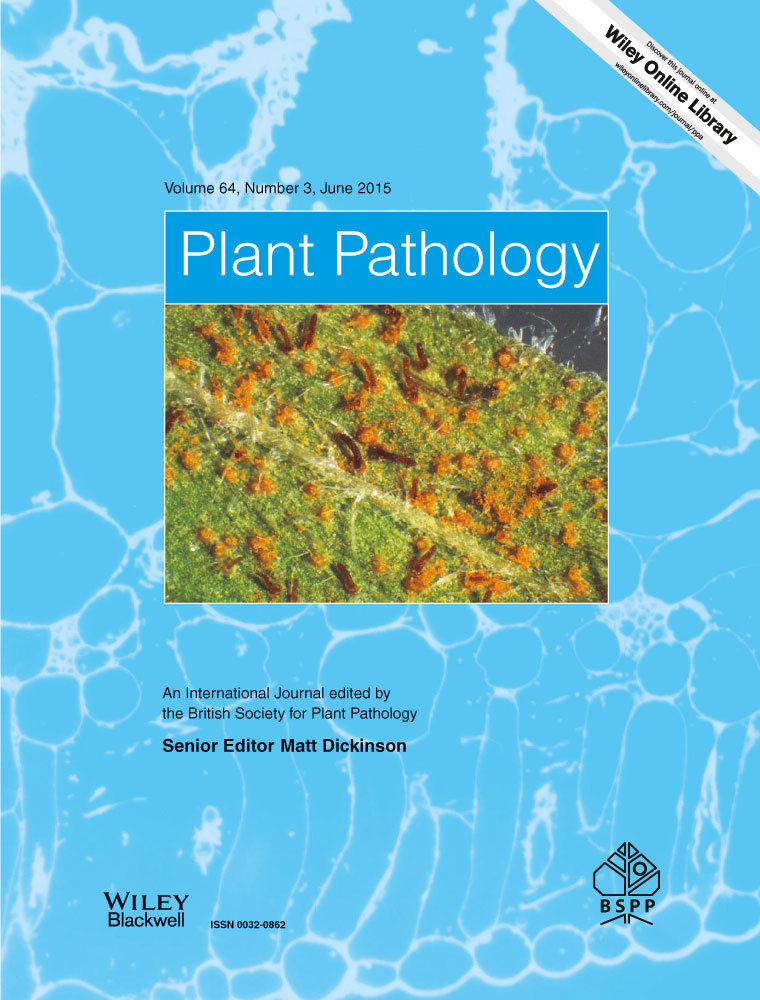Ver ítem
- xmlui.general.dspace_homeCentros e Institutos de InvestigaciónCICVyA. Centro de Investigación en Ciencias Veterinarias y AgronómicasInstituto de GenéticaArtículos científicosxmlui.ArtifactBrowser.ItemViewer.trail
- Inicio
- Centros e Institutos de Investigación
- CICVyA. Centro de Investigación en Ciencias Veterinarias y Agronómicas
- Instituto de Genética
- Artículos científicos
- Ver ítem
The origin and genetic diversity of the causal agent of Asian soybean rust, Phakopsora pachyrhizi, in South America
Resumen
A sequence‐based approach was used to investigate molecular genetic variations in Phakopsora pachyrhizi, an obligate biotrophic pathogen that causes Asian soybean rust. In Argentina, the samples came from uredinium‐bearing leaves taken from 11 soybean fields; in Brazil, the samples comprised urediniospores from leaves of 10 soybean genotypes that had been grown in three experimental stations during two growing seasons. PCR‐based cloning techniques were
[ver mas...]
A sequence‐based approach was used to investigate molecular genetic variations in Phakopsora pachyrhizi, an obligate biotrophic pathogen that causes Asian soybean rust. In Argentina, the samples came from uredinium‐bearing leaves taken from 11 soybean fields; in Brazil, the samples comprised urediniospores from leaves of 10 soybean genotypes that had been grown in three experimental stations during two growing seasons. PCR‐based cloning techniques were used to generate DNA sequences for two gene regions and alignments were supplemented with data from GenBank. A total of 575 sequences for the internal transcribed spacer region (18 ribotypes) and 160 partial sequences for a housekeeping gene encoding ADP‐ribosylation factor (10 haplotypes) were obtained. Ribotype accumulation curves predicted that about 20 bacterial clones would recover 5–6 ribotypes (c. 70–80% of the total molecular variation) per locality. The samples from the three experimental stations in Brazil displayed most (14 out of 16) ribotypes found worldwide; the lack of genetic structure and differentiation at a diverse geographic scale suggests that both local and distant sources provide airborne inoculum during disease establishment. Soybean genotypes with resistance genes for the Asian soybean rust did not decrease the molecular genetic variation of fungal populations.
[Cerrar]

Autor
Jorge, V.R.;
Silva, M.R.;
Guillin, Eduardo Alejandro;
Freire, M.C.M.;
Schuster, I.;
Almeida, A.M.R.;
Oliveira, Luiz O.;
Fuente
Plant Pathology 64 (3) : 729-737 (June 2015)
Fecha
2015-06
Editorial
Wiley
ISSN
0032-0862
1365-3059
1365-3059
Formato
pdf
Tipo de documento
artículo
Palabras Claves
Derechos de acceso
Abierto
 Excepto donde se diga explicitamente, este item se publica bajo la siguiente descripción: Creative Commons Attribution-NonCommercial-ShareAlike 2.5 Unported (CC BY-NC-SA 2.5)
Excepto donde se diga explicitamente, este item se publica bajo la siguiente descripción: Creative Commons Attribution-NonCommercial-ShareAlike 2.5 Unported (CC BY-NC-SA 2.5)


